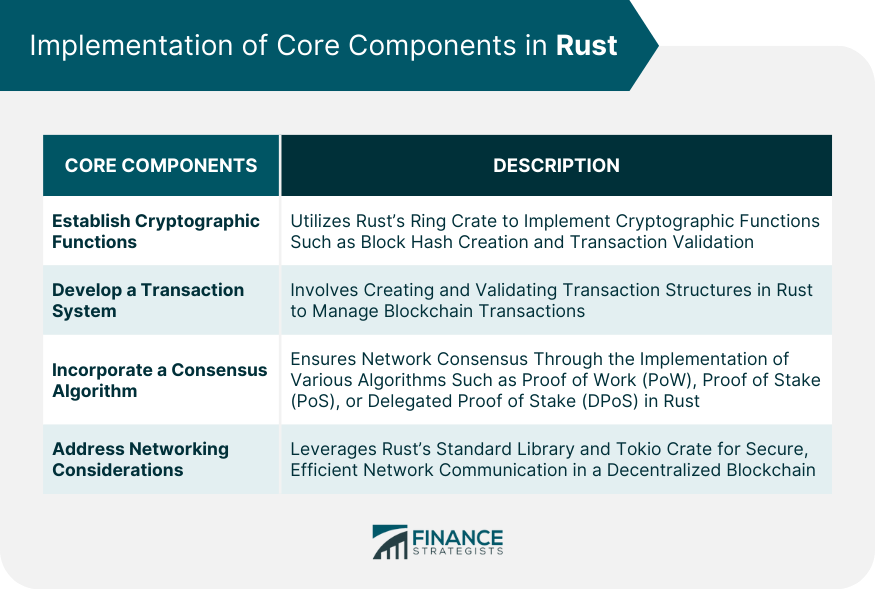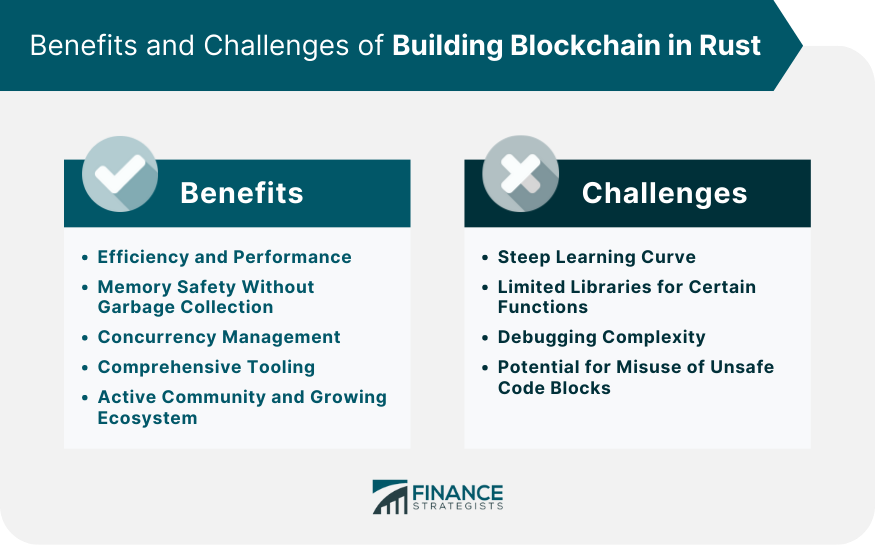Building a blockchain in Rust involves the use of the Rust programming language to create a blockchain system, a distributed and decentralized public ledger. Rust, known for its safety, speed, and concurrency, offers unique features that make it ideal for blockchain development. This process is crucial in producing blockchain systems that are less prone to programming errors, more efficient, and highly performant. The purpose of building a blockchain in Rust is to leverage Rust's robust control over system resources, memory safety without garbage collection, and advanced concurrency capabilities. These features are vital in managing blockchain's intricate elements, such as data structures, cryptographic functions, transaction systems, and consensus algorithms, thereby fostering the creation of reliable, secure, and efficient blockchain systems. Rust is a statically typed, ahead-of-time compiled language primarily designed for performance and safety, especially safe concurrency. The language offers a sophisticated control of memory layout with zero-cost abstractions, making it a favorable choice for blockchain development. In the context of blockchain, Rust's low-level control allows developers to manage data structures and algorithms for encryption, transaction handling, and consensus protocols efficiently. The architecture of a blockchain built with Rust is highly dependent on the specific requirements of the project, such as the targeted transaction speed, block size, and the chosen consensus algorithm. At its core, the architecture consists of blocks that store data and are interconnected to form the blockchain. In Rust, a Block structure can be defined to hold these data, while a Blockchain structure manages a vector of these blocks. Cryptography plays an essential role in the security and functionality of a blockchain. For instance, Rust's ring crate provides a collection of cryptographic primitives, allowing developers to implement crucial features like Secure Hash Algorithms (SHA) for creating block hashes and public-key cryptography for wallet address creation and transaction signing and verification. Transactions are the heartbeat of any blockchain, enabling the transfer of assets between parties. In Rust, a Transaction structure can be created to hold the sender's and receiver's details and the transaction amount. Additionally, transactions must be validated and added to the blockchain in a way that maintains the ledger's integrity and follows the established rules. Consensus algorithms ensure that all nodes in a blockchain network agree on the current state of the shared ledger. There are various types of consensus algorithms that can be implemented, such as Proof of Work (PoW), Proof of Stake (PoS), or Delegated Proof of Stake (DPoS). Implementing these in Rust involves designing functions that validate and add new blocks to the chain based on the chosen consensus rules. Networking is vital for a decentralized blockchain, ensuring data is reliably and securely communicated between nodes. Rust's standard library provides TCP/IP networking capabilities out of the box, and third-party crates like tokio offer asynchronous I/O, which can be used for efficient networking in a blockchain application. Rust provides control over system resources similar to languages like C and C++, enabling highly efficient code. This efficiency is beneficial in blockchain systems, where performance can significantly impact the speed of transactions and the overall usability of the network. Rust's unique ownership model prevents common memory-related errors without the need for a garbage collector. This feature is a considerable advantage for blockchain systems, where ensuring security and mitigating vulnerabilities are of utmost importance. Rust's focus on concurrency allows developers to write code that executes efficiently on modern multi-core processors, which is essential for handling many transactions in a blockchain network. Rust has a growing ecosystem of libraries and tools that streamline the development process. The package manager Cargo makes it easy to manage dependencies, build projects, and share them on crates.io, Rust's package repository. Rust has an active and rapidly growing community, which continually contributes to the language's development and ecosystem. The community support and resources available make Rust an attractive option for blockchain development. Rust is known for its steep learning curve. The language's unique features, like the ownership model and lifetimes, can be challenging for newcomers and even experienced developers transitioning from other languages. While Rust's ecosystem is growing, it still lacks compared to older, more established languages. Some specialized libraries necessary for blockchain development may not yet exist, requiring developers to build these functions from scratch. Debugging Rust code can be challenging, especially when dealing with concurrent or unsafe code. Developers must therefore have a deep understanding of the language and its quirks to effectively debug their blockchain applications. Rust allows developers to write 'unsafe' code blocks, giving them the freedom to perform low-level programming. However, this feature, if misused, can lead to vulnerabilities, something particularly undesirable in a blockchain context where security is paramount. Building a blockchain in Rust presents numerous advantages like efficiency, performance, memory safety, concurrency management, and a thriving ecosystem. However, the journey is not without its challenges, including a steep learning curve, limited libraries for certain functions, debugging complexity, and the potential misuse of unsafe code blocks. Therefore, while Rust offers promising features for blockchain development, careful consideration is necessary before embarking on such a project. Understanding the language basics, designing the right architecture, and implementing core components are crucial steps in this journey. As the Rust ecosystem grows and matures, its suitability for blockchain development will continue to improve, enabling more secure, efficient, and performant blockchain systems.What Is Building Blockchain in Rust?
Mechanics of Building Blockchain in Rust
Understanding Rust Language Basics
Designing the Blockchain Architecture
Implementation of Core Components in Rust
Establish Cryptographic Functions
Develop a Transaction System
Incorporate a Consensus Algorithm
Address Networking Considerations

Advantages of Building Blockchain in Rust
Efficiency and Performance
Memory Safety Without Garbage Collection
Concurrency Management
Comprehensive Tooling
Active Community and Growing Ecosystem
Challenges of Building Blockchain in Rust
Steep Learning Curve
Limited Libraries for Certain Functions
Debugging Complexity
Potential for Misuse of Unsafe Code Blocks

Bottom Line
Building Blockchain in Rust FAQs
Rust is a statically typed, ahead-of-time compiled language designed for performance and safety. Its unique features, such as memory safety, performance, and concurrency management, make it an excellent choice for blockchain development. It allows developers to manage data structures and algorithms for encryption, transaction handling, and consensus protocols efficiently.
Some key advantages of using Rust for blockchain development include its efficiency and performance, memory safety without the need for garbage collection, concurrency management, comprehensive tooling, and an active and growing community. These features allow for the creation of secure, efficient, and high-performance blockchain systems.
Some of the challenges include a steep learning curve, limited libraries for certain functions, complex debugging, and potential misuse of unsafe code blocks. While Rust offers promising features for blockchain development, these challenges need to be taken into account.
Cryptography is essential for the security and functionality of a blockchain. In Rust, it allows developers to implement crucial features like secure hash algorithms for creating block hashes and public-key cryptography for wallet address creation and transaction signing and verification.
Consensus algorithms ensure all nodes in a blockchain network agree on the current state of the shared ledger. There are various types of consensus algorithms, such as Proof of Work, Proof of Stake, and Delegated Proof of Stake. Implementing these in Rust involves designing functions that validate and add new blocks to the chain based on the chosen consensus rules.
True Tamplin is a published author, public speaker, CEO of UpDigital, and founder of Finance Strategists.
True is a Certified Educator in Personal Finance (CEPF®), author of The Handy Financial Ratios Guide, a member of the Society for Advancing Business Editing and Writing, contributes to his financial education site, Finance Strategists, and has spoken to various financial communities such as the CFA Institute, as well as university students like his Alma mater, Biola University, where he received a bachelor of science in business and data analytics.
To learn more about True, visit his personal website or view his author profiles on Amazon, Nasdaq and Forbes.















